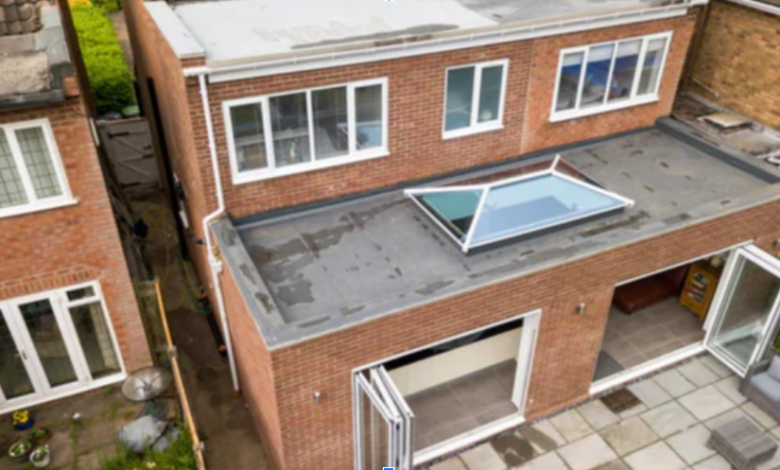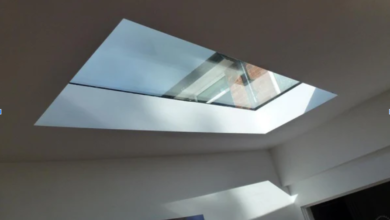Bringing Natural Light Indoors with Rooflights

Natural light has always been one of the most desirable features in any living space. From ancient architecture to contemporary design, the way a home captures and channels sunlight can transform how we feel within it. Today, one of the most effective solutions for maximising daylight is the installation of rooflights.
These innovative glazing products do much more than brighten rooms. They add a sense of openness, improve ventilation, and even contribute to the energy efficiency of a property. Whether you are renovating a Victorian terrace, building a modern extension, or simply looking to refresh a dim interior, rooflights offer a versatile and stylish option.
In this article, we will explore what rooflights are, their various types, design considerations, installation processes, benefits, and maintenance tips.
What Are Rooflights?
A rooflight is a glazed unit installed within the slope or flat surface of a roof. Unlike traditional vertical windows, they sit overhead and channel daylight directly into the interior space below. This position allows rooflights to capture more light for longer periods during the day.
They are commonly used in kitchens, loft conversions, garden rooms, and single-storey extensions. However, they can also be integrated into commercial buildings, offices, and schools to reduce reliance on artificial lighting.
The Advantages of Installing Rooflights
Homeowners and architects often choose rooflights for both practical and aesthetic reasons. Some of the most notable benefits include:
Increased Natural Light
Rooflights can introduce up to three times more daylight than standard vertical windows of the same size. This results in brighter interiors, reduced need for artificial lighting, and a more welcoming atmosphere.
Improved Ventilation
Many rooflight designs are available with opening mechanisms. This feature allows warm air to escape and fresh air to circulate, which is especially useful in kitchens and bathrooms.
Enhanced Energy Efficiency
High-performance glazing options help regulate indoor temperatures. Low-emissivity coatings, triple glazing, and insulated frames can keep heat inside during winter and reflect excess warmth in summer.
Aesthetic Value
Rooflights create striking visual effects. Sunlight passing overhead changes throughout the day, giving interiors a dynamic, ever-changing quality. At night, they provide an opportunity for stargazing directly from the comfort of your home.
Property Value
Adding rooflights can make your home more appealing to prospective buyers. Bright, airy spaces often achieve a higher market value compared to darker interiors.
Different Types of Rooflights
There is no single style that suits every building. Rooflights are available in a variety of designs to suit both pitched and flat roofs. Understanding these options will help you select the right solution.
Fixed Rooflights
These are non-opening units designed purely to bring in light. They are often chosen for living rooms, hallways, or anywhere ventilation is not required.
Opening Rooflights
Ideal for kitchens, lofts, or bathrooms, these can be opened manually or electronically. Some models include rain sensors that automatically close when wet conditions are detected.
Walk-On Rooflights
Designed with toughened or laminated glass, walk-on rooflights are installed on flat roof terraces. They provide natural light below while acting as part of the outdoor floor surface above.
Lantern Rooflights
Also known as roof lanterns, these feature a pitched, multi-panel design that creates a dramatic architectural statement. They are often used above kitchen islands or in large dining areas.
Modular Rooflights
Made to fit larger or more complex roof structures, modular systems allow multiple units to be connected seamlessly. This option is popular in contemporary extensions or commercial spaces.
See also: Everything You Need to Know About Home Buyers for Cash
Design Considerations Before Choosing Rooflights
When planning rooflight installation, several design factors should be considered to ensure the best results.
Size and Placement
A well-positioned rooflight can completely transform a room. For maximum effect, it should be located where natural light is most needed, such as over worktops, stairwells, or central living areas.
Orientation
North-facing rooflights provide soft, consistent illumination without glare, while south-facing options capture the most sunlight but may require solar control glazing to reduce overheating.
Glazing Options
From double glazing with argon gas to triple glazing with solar control coatings, choosing the right specification affects thermal performance, light transmission, and safety.
Frame Materials
Aluminium is often the preferred choice for modern rooflights due to its strength, slim sightlines, and low maintenance. Timber provides a traditional aesthetic, while uPVC offers affordability and insulation.
Privacy and Shading
Although rooflights invite sunlight, they can also expose interiors to external views. Integrated blinds or smart glass technologies can provide shading and privacy when required.
Planning Permission and Building Regulations
In the UK, rooflights usually fall under permitted development rights, meaning they often do not require planning permission. However, exceptions apply in conservation areas or listed buildings.
Building regulations must always be followed, particularly with regard to thermal performance, ventilation, and safety glazing. It is advisable to consult with your local authority or architect before proceeding.
Rooflight Installation Process
While professional installation is recommended, understanding the process helps homeowners appreciate the complexity and importance of correct fitting.
- Assessment of Roof Structure
The roof must be evaluated for load-bearing capacity and suitability for a glazed opening. Structural reinforcements may be required. - Cutting and Framing the Opening
Once the location is determined, an opening is cut and framed to support the rooflight. Proper sealing is critical to prevent leaks. - Fitting the Rooflight
The frame and glazing are installed, ensuring alignment and weatherproofing. - Insulation and Finishing
Surrounding areas are insulated to reduce thermal bridging, and internal finishes are applied to create a seamless appearance. - Testing
The rooflight is checked for water tightness, ventilation operation, and structural integrity.
Common Areas for Rooflight Installation
Rooflights can be installed in almost any part of a property. Some of the most popular applications include:
- Kitchens
Above cooking or dining areas, rooflights flood the space with light, making it feel larger and more inviting.
- Lofts and Attics
A loft conversion often relies on rooflights to transform what was once a dark attic into a usable living space.
- Extensions
Single-storey extensions particularly benefit from overhead glazing, preventing the new space from feeling cut off from natural daylight.
- Stairwells and Hallways
Narrow or windowless corridors can be dramatically improved with a well-placed rooflight, reducing the need for constant artificial lighting.
Energy Performance and Sustainability
Modern rooflights are designed with sustainability in mind. They can help reduce energy consumption by minimising reliance on artificial lighting during the day.
Glazing technology ensures heat retention in winter and reduced solar gain in summer. Some products include self-cleaning coatings that break down dirt through exposure to UV light, reducing the need for chemical cleaning agents.
By maximising natural ventilation, rooflights can also improve indoor air quality, reducing the need for mechanical systems.
Style and Architectural Impact
Beyond their functional benefits, rooflights are a powerful architectural feature. They create focal points, emphasise space, and contribute to contemporary design aesthetics.
For example, a minimalist fixed rooflight can provide sleek sophistication in a modern living room. In contrast, a traditional roof lantern adds grandeur to a period property.
By carefully choosing shape, size, and placement, rooflights can complement both new builds and historic renovations.
Safety Considerations
Safety is paramount when installing any overhead glazing. Rooflights must be manufactured with toughened or laminated glass to protect occupants in case of breakage.
Opening rooflights should include restrictors to prevent accidents, particularly in homes with children. For walk-on rooflights, non-slip surfaces and structural load testing are essential.
Maintenance of Rooflights
Regular care ensures rooflights perform well and remain visually appealing.
- Cleaning Glass: Use non-abrasive cleaners and soft cloths to prevent scratches. Self-cleaning coatings can reduce effort.
- Checking Seals: Inspect seals periodically for wear or damage that could allow water ingress.
- Operating Mechanisms: Ensure hinges, handles, and motors are functioning smoothly.
- Condensation Management: Maintain adequate ventilation in rooms to reduce condensation build-up on glazing.
Future Trends in Rooflight Design
Advances in technology are shaping the future of rooflight design. Smart glass that adjusts tint automatically, integrated solar panels, and app-controlled opening systems are becoming more common.
Architects are increasingly combining multiple units to create large glazed ceilings, blurring the boundaries between indoor and outdoor living. Sustainability will continue to influence designs, with greater emphasis on energy performance and eco-friendly materials.
Conclusion
Rooflights are far more than just an architectural feature. They offer a way to transform homes with natural light, fresh air, and modern design. From fixed models to dramatic roof lanterns, the variety available means there is a solution for every property.
By carefully considering placement, glazing, and design, homeowners can achieve spaces that feel brighter, more spacious, and more sustainable. For those planning a renovation or extension, investing in rooflights can truly elevate the comfort and value of a home.




